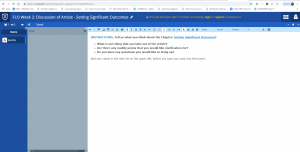Module 2: Learning Activity 1 – Approaches to Setting Outcomes
The first activity in this module will take you through multiple steps to acquaint you with a number of approaches that you can take to formulate your own course level outcomes.
Instructions for STEP 1: Reading
- Please read the second chapter in Niilson & Goodson’s book: Online teaching at its Best by clicking on the following link: Setting Significant Outcomes. The document will open in a separate tap, so you can navigate back to this lesson on top of your screen.As you go through the reading, please consider the following guiding questions to help you process the material:
- What’s the danger of designing a course from an instructional designs systems approach?
- Why do the authors suggest to determine the pedagogy before the actual course design?
- What elements do the authors suggest outcomes should include?
- How can we “exploit the power of design”?
- What constitutes ‘significant learning’?
- Share your understanding of the article with us by accessing the collaborative Cryptpad (accessible to FLO participants only) below.

Instructions for STEP 2: Learn about Backward Design
When speaking of ways to begin reflecting on significant learning potential of specific courses, Niilson & Goodson mention a few different approaches. This part of the lesson will allow us to look a little closer at the approach McTighe and Wiggins take to course design.
Backward Design
In the first chapter of the book ‘Understanding by Design’, Wiggins & McTighe (2005) make the case for a standards-informed practice that guides us in the identification of teaching and learning priorities and the design of well-aligned courses that are also inclusive to our varied student populations.

“Good design”, the authors posit “is not so much about gaining a few new technical skills as it is about learning to be more thoughtful and specific about our purposes and what they imply.” (p.14) What the authors here mean when speaking about thoughtfulness and specificity is an approach that is referred to as ‘Backward Design’, which much like the name implies starts out from the end point in instruction, namely the learning goals.
- You can either watch a following video (about 10mins.) or read the the first chapter (reference above) to find out why the authors argue for Backward Design as the approach to planning courses.
- Take the quiz once you think you got the answer to 1.
Instructions for Step 3: Reflection
Reflect on the 2 readings to let us know what your impressions are. What is your approach to designing academic courses? What does your initial planning stage usually look like? How do you define significant learning? (minimum 250 words).
- What approach(es) would you like to apply to designing online courses?
- Why?
- Please feel free to leave comments or questions for the instructor who will be reading your reflections.

